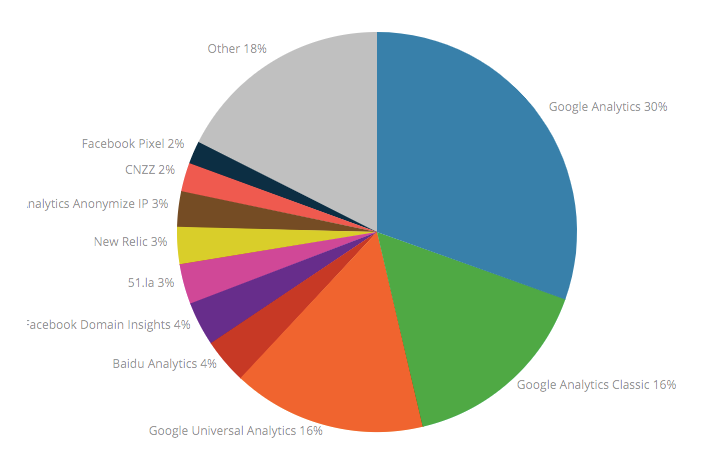“Information is the oil of the 21st century, and analytics is the combustion engine.”
– Peter Sondergaard, Senior Vice President, Gartner
Big data is taking over. With the rise of the internet, IoT and consumer electronics like the smartphone, people are creating more and more usable data every day. Our world is slowly becoming digitized and with that transformation, a massive swell of information is now at our fingertips. Because of this, collecting information is easy. Properly understanding and leveraging this information is the hard part.
Everyone wants to be a part of the big data revolution, but so far there really aren’t a lot of companies that are properly implementing big data. One of the areas that big data is readily available for implementation is digital marketing. Through tools like Google Analytics, we are able to gain vast amounts of data from a website’s users that can be put to work.
What is big data?
It is hard to imagine being able to avoid hearing about how companies and organizations are using big data to create efficiency, cure disease, observe distant planets, or identify what you might like to view most in your Netflix queue. There are a staggering number of uses for big data and it seems like every organization wants to find out how they can leverage it to work for them. Big data is essentially any large data set that can be analyzed for trends, patterns, behaviors, and interactions.
Big Data and Digital Marketing
Big data has become a must for successful digital marketing campaigns and is what has proven them to be more effective than traditional forms of advertising. With the additional data available to marketers, we can remove the guesswork from a campaign and adjust more quickly to changing trends, successes, and failures that were possible through more traditional mediums.
Where does big data come from?
There are a few kinds of data that are particularly relevant to digital marketing. The first, and arguably most important, is search data. Search engine data can inform a marketer of current trends, consumer behaviors, and intent. Understanding how your target market is searching for your product or service online is imperative to making educated decisions about search engine marketing. A business can use search data to create a targeted online audience and maximize their visibility in front of consumers who are actively looking for their product or service at the moment of need.
Social media can also provide a plethora of useable information. The average American spends nearly 2 hours on social media every day. From social networks, we can collect a wide range of data, from demographics like age, gender, and education level to behaviors like what brands users follow, shopping preferences, and personal tastes. Being able to identify traits of your user base can be extremely helpful when trying to expand or market towards those users.
Web mining – collecting information from applications, browsers, server logs, web page traffic, interactions and other sources – is another source of information that is extremely important to optimize digital marketing efforts. Web mining is a fantastic resource that has the ability to inform us on what actions our users are taking, and equally important, what actions they aren’t taking when interacting with a business’s website or application.
Understanding what you see
“Getting information off the Internet is like taking a drink from a firehose.”
– Mitchell Kapor, Partner, Kapor Capital
The quantity of available data can be overwhelming and has led to a rise in available analytics tools for understanding and parsing all of the information. Tools like Google Analytics, Kissmetrics, Quantcast, or SEM Rush have become imperative for organizations of all sizes. To illustrate how pervasive these tools are, according to BuiltWith.com almost 30,000,000 live websites currently have Google Analytics installed and over 62% of all sites in the United States utilize a form of Google Analytics.

Even with tools like Google Analytics, collecting and parsing the data is only half the challenge.
The real value of skilled digital marketers lies in being able to analyze the data and make educated conclusions about it.
When analyzing big data, we need to be wary of getting misled and coming to incorrect deductions. Our favorite cautionary story is that of Abraham Wald, a statistician during WWII who was charged with identifying how best to implement additional armor on fighter planes. He began by analyzing the location of bullet holes on planes that had returned from combat to determine what areas of the plane are most likely to be hit and thus needed the most armor. What they found was that bullet holes per square foot were low over the engine but high over the fuselage and other areas of the plane. This is the data they had to work with.
| Section of plane | Bullet holes per square foot |
|---|---|
| Engine | 1.11 |
| Fuselage | 1.73 |
| Fuel System | 1.55 |
| Rest of the plane | 1.8 |
The officers saw this and came to the easy conclusion that since the engine casing and fuel system were being hit less, they should add armor to other areas of the plane that get hit the most. Wald’s determination was exactly the opposite, he determined the armor needed to be added to the areas where the bullet holes aren’t. Wald took a step back and asked, why are there so many fewer bullet holes over the engine casing? The missing bullet holes were on the missing planes. The reason planes were coming back with fewer hits to the engine is that planes that got hit in the engine weren’t coming back.
Whenever you’re viewing your data be sure not to fall into the bullet hole trap. It’s imperative to understand how you collect your data and what gaps you need to account for when analyzing it.
Implementing Big Data in your campaigns
The first step to implementing big data is to identify business goals. The most important data to one organization may not be the same as what’s important to others. Every business is unique and identifying short and long term goals will help guide which types of data an organization should be focusing on most.
With goals in place, it is time to choose the right data sets. At this point it is important to identify what information you have available, and what metrics will have the greatest influence on success. Some simple common metrics are total traffic to the website, purchases and ROI, online user interactions, or resource downloads. Focusing on patterns of users who follow-through with your desired actions, and finding ways to remove roadblocks for those who aren’t, is always a great place to start.
To stay competitive in today’s digital marketplace, utilizing big data is a must. Tracking successes and failures so your campaigns can adjust to trends and insights will help drive success in any organization.





